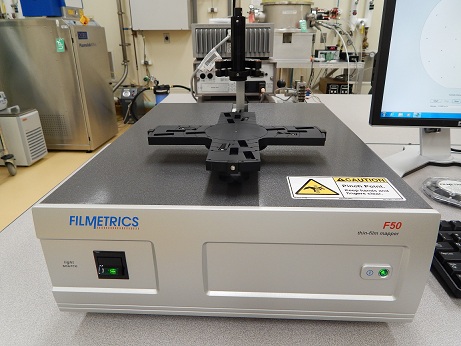
Updated on 10/2/2014

1 Start-up
2 Reference check
2.1 Baseline setting
2.1.1 Measure Tab
2.1.2 Step 1
2.1.3 Step 2
2.2 Check standard SiO2 reference wafer
3 One spot measurement to confirm the best fitting
3.1 Baseline setting
3.1.1 Measure Tab
3.1.2 Step 1
3.1.3 Step 2
3.2 Confirm the fitting of measured data with calculated data
4 Creating/editing wafer mapping recipes
5 Running wafer mapping recipe and reviewing data
6 Leaving the tool in an “idle” state
7 Supplemental Documents
1. Turn on light source on front panel of main F50 unit
2. Wait at least 5 minutes for proper lamp warm-up
3. Ensure “FILMapper” software program is open
1. Locate the 4” Filmetrics wafer labeled “Si Reference Wafer” and "SiO2 on Si Test wafer".
2. Click the “Measure” tab at the top of the screen
3. Click “Baseline” and follow on-screen instructions
1. The following dialog box appears.
5. Place the "SiO2 on Si Test wafer" on the stage.
6. Click the "Take Sample Reflectance" button.
1. The dialog box for step 2 appears when step 1 is completed.
2. Place the "Si Reference wafer" on the stage.
3. Choose "Si" from the "Reflectance Standard" pull-down menu of box.
4. Click the "Take Reflectance Standard" button.
5. Remove the Si Reference wafer when it is done.
1. Locate the 4” Filmetrics wafer labeled “SiO2 on Si Test Wafer”
2. Place the Test Wafer on the stage.
3. While still on the “Measurement” screen, click the “go to” button.
4. The following dialog box appears. Set coordinates to X=0, Y=0 and click “ok”.
5. Select “SiO2 on Si” from the pull-down menu above the “Edit Recipe” button and click “OK”.
6. Click “measure” to obtain SiO2 thickness (standard = 7268.7Å)
7. Remove the Test Wafer from the stage.
* Note: If the substrate of your sample is still a Si wafer after the above process, then skip 3.1, and go to 3.2.
1. Click the “Measure” tab at the top of the screen
2. Click “Baseline” and follow on-screen instructions
1. The following dialog box appears.
5. Place the sample wafer to be measured on the stage.
6. Click the "Take Sample Reflectance" button.
1. The dialog box for step 2 appears when step 1 is completed.
2. Place the blank substrate on the stage.
3. Choose the substrate material from the pull-down menu of the "Reflectance Standard" box.
4. Click the "Take Reflectance Standard" button.
5. Remove the the blank substrate when it is done.
1. Place the sample on the stage.
2. Click the “Go To” button in the “Measure” tab.
3. The following dialog box appears. Set coordinates to X=0, Y=0 and click “OK”. The sample wafer will move beneath the optical fiber probe.
4. Click the “Edit Recipe” button to open the “Edit Recipe” window.
5. Click “Film Stack” to add, remove, or change film types in the stack to be measured.
6. Save an edited recipe as a new recipe, if necessary.
7. Click the "Measure" button.
8. Make sure that the fitting of measured data with calculated data is good enough.
1. Open the "Edit Recipe" dialog box.
2. Click “wafer map” and select appropriate wafer diameter, desired coordinate system (“polar” is recommended, to start), number of points to be measured, desired edge exclusion, and appropriate wafer indexing (flat, notch, etc.)
3. Save the recipe, if necessary.
1. On the “WaferMap” tab/screen, click “new” and fill-in the wafer ID
2. Click “start” to run wafer mapping recipe
3. Once completed, review measurement data in the lower right of the screen under “results”.
4. Under “Display”, select 2D or 3D wafer map for review, as desired
5. If multiple layers exist, each can be viewed individually by using the “Parameter to Display” pull-down menu
6. To run another wafer, click “new”, fill-in the wafer ID, and click “start”
1. When done using the F50, turn off the light source only, unless another will be using the tool immediately after you
2. Leave the FILMapper software open
3. Leave main unit power on